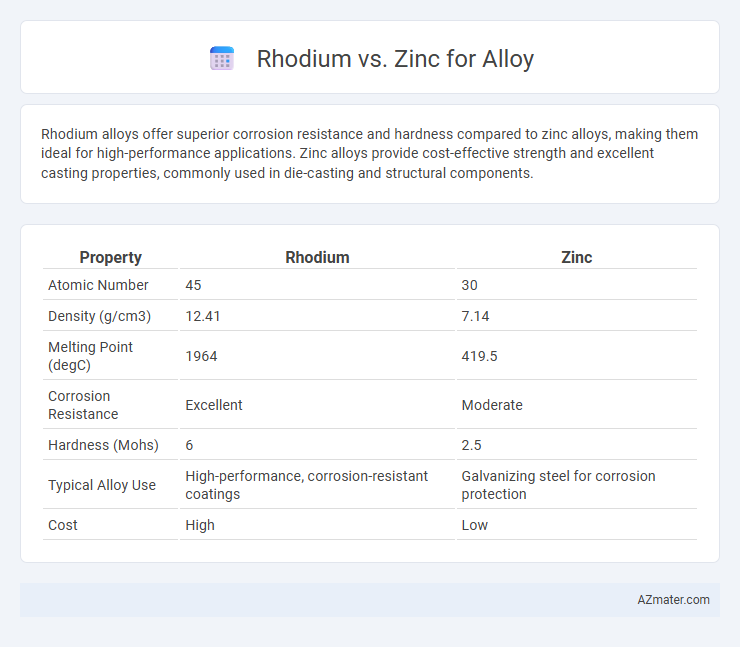Rhodium alloys offer superior corrosion resistance and hardness compared to zinc alloys, making them ideal for high-performance applications. Zinc alloys provide cost-effective strength and excellent casting properties, commonly used in die-casting and structural components.
Table of Comparison
| Property | Rhodium | Zinc |
|---|---|---|
| Atomic Number | 45 | 30 |
| Density (g/cm3) | 12.41 | 7.14 |
| Melting Point (degC) | 1964 | 419.5 |
| Corrosion Resistance | Excellent | Moderate |
| Hardness (Mohs) | 6 | 2.5 |
| Typical Alloy Use | High-performance, corrosion-resistant coatings | Galvanizing steel for corrosion protection |
| Cost | High | Low |
Introduction to Rhodium and Zinc Alloys
Rhodium alloys exhibit exceptional corrosion resistance, high reflectivity, and superior hardness, making them ideal for catalytic converters and jewelry plating. Zinc alloys, widely used in die casting, offer excellent strength, moderate corrosion resistance, and cost-efficiency for automotive and consumer electronics applications. The distinct metallurgical properties of rhodium and zinc alloys determine their suitability for specialized industrial uses and decorative purposes.
Chemical Properties: Rhodium vs Zinc
Rhodium exhibits exceptional chemical stability, resisting oxidation and corrosion due to its noble metal characteristics, making it ideal for high-durability alloys. Zinc, with moderate reactivity, readily oxidizes and forms a protective oxide layer, enhancing corrosion resistance in alloys like brass. The distinct electron configurations and chemical reactivity of rhodium and zinc influence their respective alloy applications, where rhodium provides superior resistance and zinc contributes to malleability and corrosion protection.
Physical Characteristics Comparison
Rhodium exhibits a high melting point of 1964degC and exceptional hardness, making it ideal for durable alloys, while zinc melts at 419.5degC and is much softer and more malleable. Rhodium's density is approximately 12.41 g/cm3, significantly higher than zinc's 7.14 g/cm3, influencing the weight and strength of the resulting alloys. The corrosion resistance of rhodium surpasses zinc, contributing to longevity in high-performance applications.
Corrosion Resistance Capabilities
Rhodium exhibits superior corrosion resistance compared to zinc, making it highly valuable in alloy compositions exposed to harsh environments and chemicals. Zinc alloys tend to corrode faster due to their susceptibility to oxidation and acid attack, which limits their effectiveness in long-term protective coatings. Incorporating rhodium in alloys enhances durability and prevents surface degradation, especially in high-performance industrial and automotive applications.
Strength and Durability Assessment
Rhodium alloys exhibit exceptional strength and remarkable corrosion resistance, making them highly durable under extreme conditions. Zinc alloys, while cost-effective and offering moderate strength, tend to have lower durability due to susceptibility to corrosion and wear over time. The superior hardness and oxidation resistance of rhodium make it the preferred choice for applications demanding long-lasting structural integrity.
Common Industrial Applications
Rhodium is primarily used in high-performance catalytic converters, electrical contacts, and jewelry alloys for its exceptional corrosion resistance and high reflectivity. Zinc is widely employed in galvanization to protect steel from rust, die-casting for automotive and hardware components, and as an essential element in brass alloys for improved strength and machinability. Both metals enhance alloy properties but serve distinct roles based on their industrial application requirements.
Cost and Availability Analysis
Rhodium, a rare and precious metal, commands a significantly higher price than zinc due to its scarcity and extensive industrial demand, with costs often exceeding thousands of dollars per ounce compared to zinc's affordable few dollars per pound. Zinc is abundantly available globally, making it a cost-effective choice for alloy production, whereas rhodium's limited supply and complex extraction processes contribute to its high cost and constrained availability. Alloy manufacturers favor zinc for large-scale applications to manage expenses, while rhodium is reserved for specialty alloys requiring superior corrosion resistance and catalytic properties despite its premium price.
Environmental Impact and Sustainability
Rhodium, a rare and precious metal, offers significant corrosion resistance and durability but has a substantial environmental impact due to its energy-intensive mining and scarcity, which raises sustainability concerns. Zinc, more abundant and recyclable, presents a lower environmental footprint and is often used in alloys for galvanized coatings to prevent rust, supporting sustainable manufacturing practices. Choosing zinc over rhodium in alloys can reduce ecological damage and promote resource efficiency, aligning with green engineering principles.
Alloying Compatibility with Other Metals
Rhodium exhibits excellent alloying compatibility with platinum, palladium, and other platinum-group metals, enhancing corrosion resistance and surface hardness in catalytic and jewelry applications. Zinc, commonly alloyed with copper to form brass, improves strength and ductility but has limited compatibility with noble metals due to its reactivity and lower melting point. In advanced alloys, Rhodium offers superior stability and durability when combined with precious metals, while Zinc remains vital in structural alloys requiring cost-effective reinforcement.
Choosing the Right Metal: Rhodium or Zinc?
Rhodium offers superior corrosion resistance, hardness, and reflective properties, making it ideal for high-quality, durable jewelry and plating applications. Zinc, being more abundant and cost-effective, provides good malleability and corrosion resistance primarily in galvanizing steel and die-casting alloys. Selecting the right metal depends on the specific application requirements, budget constraints, and desired durability, with rhodium favored for luxury finishes and zinc chosen for industrial and cost-sensitive uses.

Infographic: Rhodium vs Zinc for Alloy
 azmater.com
azmater.com